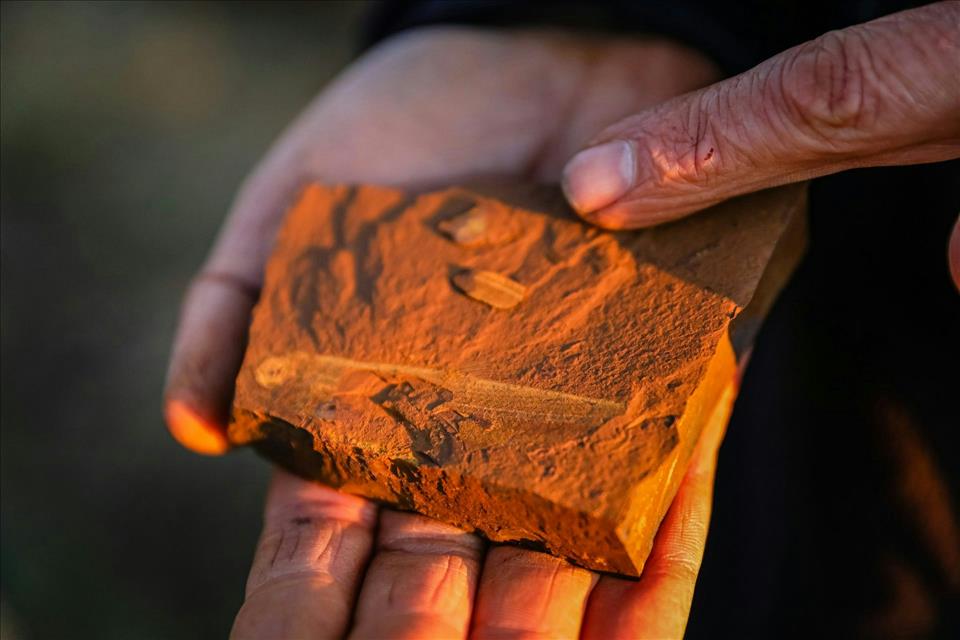
Unusual Red Rocks In Australia Are Rewriting The Rules On Exceptional Fossil Sites
It is here that palaentologists and geologists from the Australian Museum Research Institute have made remarkable fossil discoveries . Where dust and drought now dominate, a lush rainforest once flourished. In stunning ecological detail, fossils at McGraths Flat reveal this ancient ecosystem.
Strikingly red in appearance, the sedimentary rocks here are composed entirely of goethite – a fine-grained mineral that contains iron. This iron has preserved a range of plants, insects, spiders, fish and feathers with exceptional detail.
Our new study , published in the journal Gondwana Research, shows there's another reason these rocks are so intriguing. They fundamentally challenge ideas about where well-preserved fossil sites on Earth can be found, and why.
A large trapdoor spider preserved in McGraths Flat. Michael Frese Beyond shale and sandstone
Traditionally, the most exceptionally well-preserved fossil sites are from rocks dominated by shale, sandstone, limestone, or volcanic ash.
Consider Germany's Messel Pit or Canada's Burgess Shale . At these sites, organisms were rapidly buried in fine-grained sediments, allowing the exceptional preservation of soft tissues, not just hard parts.
Messel Pit has preserved roughly 47 million-year-old fossils showing the outlines of feathers , fur and skin . Meanwhile, the Burgess Shale contains soft tissues from some of Earth's earliest animal life, dating back about 500 million years.
By contrast, sedimentary rocks made entirely of iron are the last place you'd expect to find well-preserved remains of land-based (terrestrial) animal and plant life.
That's because iron-rich sedimentary rocks are predominantly known from banded iron formations . These massive iron deposits largely formed around 2.5 billion years ago in Earth's ancient oxygen-depleted oceans, long before complex animal and plant life evolved.
In more recent history, iron is considered a mere weathering product, forming rust on the continents when exposed to our oxygen-rich atmosphere. Just look at Australia's iconic red-rocked outback landscape that preserves these million- to billion-year-old features.
Yet the discovery of McGraths Flat has defied these expectations.
Strikingly red fossil-bearing rocks of McGraths Flat, composed of an iron-oxyhydroxide mineral called goethite. Tara Djokic Terrestrial life entombed in iron
McGraths Flat is made from a very fine-grained, iron-rich rock called ferricrete. It's essentially a cement made from iron.
The ferricrete consists almost entirely of microscopic iron-oxyhydroxide mineral particles, each just 0.005 millimetres across. When an animal died and was buried in the sediment, this minute scale is what allowed the iron particles to fill every cell. The result? Extraordinarily well-preserved soft tissue fossils.
Compared with marine life, fossil sites preserving terrestrial life are notoriously rare. Terrestrial sites that preserve soft tissues? Even rarer. The exceptional detail captured in the McGraths Flat fossils reveals new snapshots of past life we don't often get to find.
These fossils are so perfectly preserved that individual pigment cells in fish eyes, internal organs of insects and fish, and even delicate spider hairs and nerve cells can be seen.
This level of preservation rivals other well-preserved fossil sites, such as those consisting of shale or sandstone. Except here, they are entombed in iron.
Australian Museum Research Institute researchers Matthew McCurry, Tara Djokic and Patrick Smith (left to right), three of 15 co-authors who collaborated on this study published in Gondwana Research. Salty Dingo How did McGraths Flat form?
Our new study sheds light on how this fossil site came to be – a crucial step for finding similar terrestrial fossil troves in iron.
McGraths Flat began forming during the Miocene when iron leached from weathering basalt under warm, wet rainforest conditions.
Acidic groundwater then carried the dissolved iron underground until it reached a river system with an oxbow lake – an abandoned river channel. There, the iron became ultra-fine iron-oxyhydroxide sediment.
It rapidly coated dead organisms on the lake floor and replicated their soft tissue structures down to the cellular level.
A new fossil roadmapUnderstanding how McGraths Flat formed could provide a roadmap for finding similar iron-rich fossil sites worldwide.
Key features to look for include very fine-grained and finely layered ferricrete in areas where:
-
ancient river channels cut through older iron-rich landscapes, such as basaltic rocks from volcanoes
ancient warm, humid conditions once promoted intense weathering, and the surrounding geology lacks significant limestone or sulphur-containing minerals (such as pyrite), because these could interfere with the formation of the iron-oxyhydroxide mineral sediments.
The red rocks of McGraths Flat open an entirely new chapter in our understanding of how exceptionally well-preserved fossil sites can form.
The next breakthrough in understanding ancient terrestrial life might not come from traditional shale or sandstone fossil beds, but from rusty-red rocks hidden beneath our feet.
Palaeontologists from the Australian Museum Research institute at the McGraths Flat field site, splitting the red rocks apart with a hammer and chisel to search for fossils. Tara Djokic
The study's authors acknowledge the traditional custodians of the land and waterways on which McGraths Flat is located, the Wiradjuri Nation people.

Legal Disclaimer:
MENAFN provides the
information “as is” without warranty of any kind. We do not accept
any responsibility or liability for the accuracy, content, images,
videos, licenses, completeness, legality, or reliability of the information
contained in this article. If you have any complaints or copyright
issues related to this article, kindly contact the provider above.

















Comments
No comment